Canaria in a Gold Mine
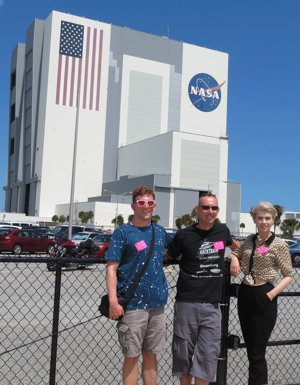 Since winning at Space Apps London 2016 and going on to win the Best Use of Hardware award in the NASA global Space Apps judging, Rob Finean, Alex Moss, and James Lynn, the three partners that created Canaria, have been busy!
Since winning at Space Apps London 2016 and going on to win the Best Use of Hardware award in the NASA global Space Apps judging, Rob Finean, Alex Moss, and James Lynn, the three partners that created Canaria, have been busy!
Anticipating Space Apps 2016, her first hackathon ever, Alex had wanted to come prepared. Looking through the Space Apps resources online, she had seen the Wearables section, which reminded her of her former career in fashion and design. “I was thinking of carbon dioxide because I wanted to retrain and move into tech,” she remembers. “I started reading public NASA research papers, some papers from the Italian Space Agency, and endless YouTube footage of astronauts, trying to get an idea of the problems that humans face in space,” says Alex.
The whole time, she was fiddling with her earring, and then she realized that she never noticed it. Her background interest in neurology told her that this was an ideal site for a new kind of Wearable, as you will see. So she combined the two ideas to write a pitch for the Space Apps weekend.
At Space Apps London, the Pitch Session was near its end before Alex worked up the courage to take her idea onstage. “The pitches that came before me were absolutely amazing and technically sophisticated. My idea was for an ear cuff!” she laughs.
The pitches that came before me were absolutely amazing and technically sophisticated. My idea was for an ear cuff!Alex Moss, Team Canaria
Nevertheless, her pitch for a wearable carbon dioxide sensor instantly got Rob and James’s attention— and Team Canaria was born!
Rob, an electronics engineer, had done quite a few hackathons already. He has also had a career in communications, including satellite communications, and a strong interest in medical applications. James, a student in Electronic Engineering with Space Systems at the University of Surrey, is part of the Electronics Society and had participated in Space Apps London the year before.
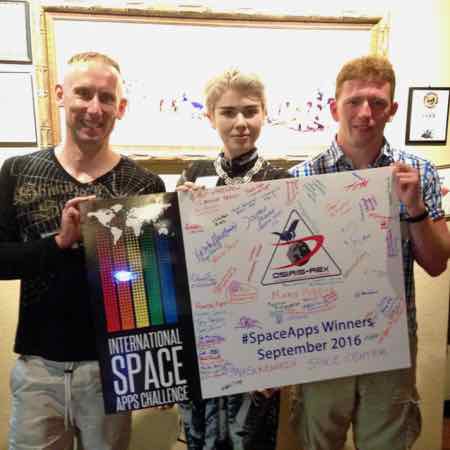
So what’s the rest of the story? How did three people with completely different backgrounds and skill sets fare as a team at Space Apps London? The answer is… famously!
Named after the canaries used in 19th Century mining to detect hazardous air quality conditions, “Canaria represents what a canary might look like now, in the era of space travel,” explains Alex. Designed to detect pockets of hazardous gas aboard the International Space Station (ISS), the Canaria would be worn on the cuff of an astronaut’s ear like a Bluetooth device.
Canaria represents what a canary might look like now, in the era of space travel!Alex Moss
“There are fewer nerves in that part of the ear, so the device becomes virtually imperceptible,” says Alex. She proved this point herself when she accidentally lost the plasticine prototype she was wearing at 4:00 am during the 48-hour Space Apps hackathon: “We were tired! And it really is unnoticeable!”
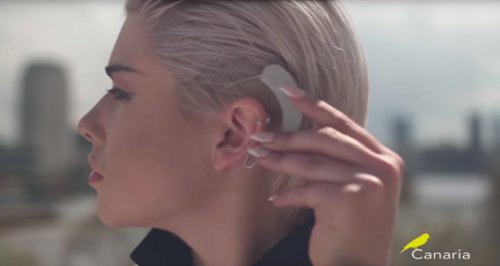 Luckily, they found the prototype, and during the Space Apps weekend, what started as a carbon dioxide monitor evolved into a biometrics-measuring tool as well. Their prototype could sense heart rate and blood oxygen levels, and the team has since added respiration rate detection capabilities to the device as well!
Luckily, they found the prototype, and during the Space Apps weekend, what started as a carbon dioxide monitor evolved into a biometrics-measuring tool as well. Their prototype could sense heart rate and blood oxygen levels, and the team has since added respiration rate detection capabilities to the device as well!
“We knew we had stumbled upon something really special with the tool,” explains Rob, “so we decided to set up a company even before we knew what the Space Apps global judging results were.” Soon after, they obtained Patent Pending status in the US, and were on their way to building a successful company!
We knew we had stumbled upon something really special with the tool, so we decided to set up a company even before we knew what the Space Apps global judging results were!Rob Finean, Team Canaria
Now coming up on their first birthday, they have since incorporated their company, been developing a working prototype, and been researching the space, medical and mining industry markets. “We’ve been working out which industry we were best suited to,” says James. “There are so many use cases: mining, cycling, healthcare…. We needed to have a defined direction.”
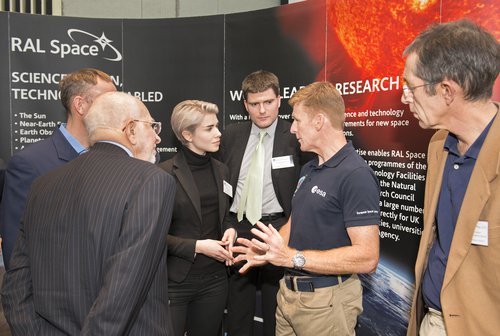 After much research and interviewing people, the team has decided to begin with advancing Canaria’s development for the mining industry. “This use case is almost an exact replica of use aboard the ISS,” they say. Not only would Canaria enable miners to detect hazardous gases, but with the newly integrated artificial intelligence tools in the device, Canaria would enable mining companies to predict when an accident is going to take place.
After much research and interviewing people, the team has decided to begin with advancing Canaria’s development for the mining industry. “This use case is almost an exact replica of use aboard the ISS,” they say. Not only would Canaria enable miners to detect hazardous gases, but with the newly integrated artificial intelligence tools in the device, Canaria would enable mining companies to predict when an accident is going to take place.
Additionally, the Canaria team has encountered a lot of enthusiasm for their device from the healthcare sector, where there’s a lot of interest in recording patient vital signs efficiently. The company has been building relationships in the United Kingdom’s National Health Service (NHS), with researchers at Oxford University, and in the Oxford Academic Heath Science Network, which is responsible for bringing new technology into the NHS healthcare industry.
Team Canaria’s plan is to spend five years conducting research and testing in the mining sector, and then to launch into the healthcare sector in countries like the UK, Norway, and Sweden. “We could develop a system that predicts serious medical events before they actually happen,” says Rob, who estimates that it would take about five years to replace the vital signs equipment currently used in the NHS.
We could develop a system that predicts serious medical events before they actually happen.Rob Finean
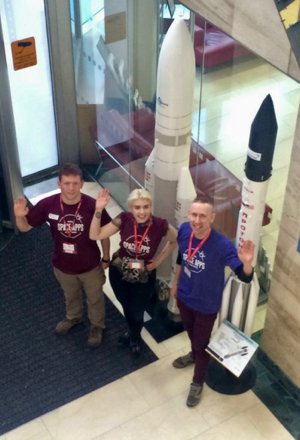 And what about their original use case for NASA? Canaria has not forgotten its space-based roots! The team’s long-term plans include developing their device towards applications for the ISS, aiding research in space and space tourism. To that end, they have already talked about it with European Space Agency (ESA) astronaut Major Tim Peake, and they are building relationships with the ESA with the goal of getting Canaria into space in the next ten years!
And what about their original use case for NASA? Canaria has not forgotten its space-based roots! The team’s long-term plans include developing their device towards applications for the ISS, aiding research in space and space tourism. To that end, they have already talked about it with European Space Agency (ESA) astronaut Major Tim Peake, and they are building relationships with the ESA with the goal of getting Canaria into space in the next ten years!
Three cheers to Canaria, a Space Apps project that started with an idea to help astronauts aboard the ISS, that is now set to revolutionize the mining and healthcare industries!
And we’re not the only ones who have noticed! Leaders in the technology and industry sectors have been watching Canaria’s growth with enthusiasm. In fact, Canaria was voted one of the Top Ten Startups in Richard Branson’s Extreme Tech Challenge in 2017! “We got to go to Las Vegas to pitch to a room of a few hundred people,” says James. “We even got an invitation to Richard Branson’s island!” Did you go? —we asked, excited! “No,” they chuckled…. “We needed the money to pay our patent attorney!”
Such is life in a startup! LOL!